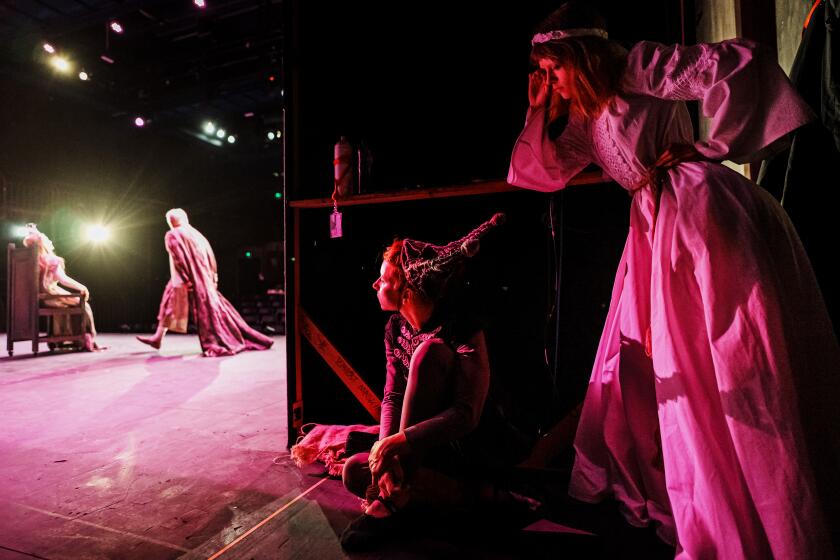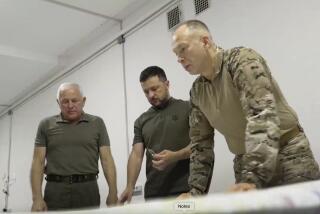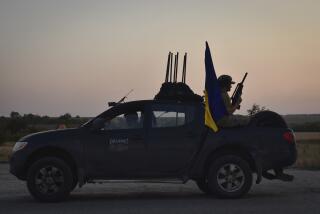Civilians flee key Ukrainian city as Russia’s army bears down in the east

- Share via
POKROVSK, Ukraine — Civilians holding small children and lugging heavy suitcases fled Monday from Ukraine’s eastern city of Pokrovsk, where the Russian army was bearing down fast despite a lightning Ukrainian incursion into Russia’s Kursk region.
Local authorities said Russian forces were advancing so quickly that families were under orders to leave the city and other nearby towns and villages starting Tuesday. About 53,000 people still live in Pokrovsk, officials said, and some of them decided to get out immediately.
Some people wept as they waited for trains and buses to depart. Soldiers helped elderly people with their bags, and volunteers helped people with disabilities. Rail workers wore bulletproof vests.
Natalya Ivaniuk said the noise of explosions from Russian bombardments filled the air while she and her daughters, ages 7 and 9, fled their home in the nearby village of Myrnohrad, which is less than six miles from the front line.
“It was terrifyingly scary,” she said. “We barely got out.”
Pokrovsk is one of Ukraine’s main defensive strongholds and a key logistics hub in the Donetsk region. Its capture would compromise Ukraine’s defensive abilities and supply routes and would bring Russia closer to its stated aim of capturing the entire Donetsk region.
Ukrainians displaced by war find new purpose in Shakespeare’s play of love, loss and madness, bringing their blood-red version to the bard’s hometown.
One of Ukraine’s attempts to ease the pressure on its eastern front was the unexpected Aug. 6 incursion into Russia’s Kursk region. Among other goals, the incursion was intended to unnerve the Kremlin and compel it to split its military resources.
Ukrainian President Volodymyr Zelensky said Sunday the cross-border attack was also aimed at trying to create a buffer zone that might prevent further attacks by Moscow across the border, especially with long-range artillery, missiles and glide bombs.
In a social media statement, Zelensky said Monday evening that Ukraine controlled about 480 square miles and 92 settlements inside the Kursk region.
“The Russian border area opposite our Sumy region has been mostly cleared of Russian military presence,” he said. “Now, our warriors’ real success speaks for itself. Our defensive actions across the border, as well as Putin’s inability to defend his territory, are telling. Our proactive defense is the most effective counter to Russian terror, causing significant difficulties for the aggressor.”
Russia’s relentless six-month slog across Ukraine’s Donetsk region following the capture of Avdiivka has cost it heavily in troops and armor. However, the onslaught has gradually paid dividends as Ukrainian defenders have no choice but to pull back from positions blown to pieces by Russian artillery, missiles and bombs.
“There is a lot of destruction around us, so it becomes more and more scary to stay,” said Tetiana Myronenko, 57, who came from Selydove, just three miles from the front line.
She sat next to her husband in the car of a train waiting to leave Pokrovsk. It was bound for Lviv, hundreds of miles away in western Ukraine.
Russia is keeping up its assault on Ukraine as Kyiv’s forces push farther into the Kursk region across the border.
Russia wants control of all parts of Donetsk and neighboring Luhansk, which together make up the Donbas industrial region.
Officials warned last week that Russian forces were rapidly advancing and were six miles from the outskirts of Pokrovsk.
Oleksandr Syrskyi, Ukraine’s commander-in-chief, said Monday that “heavy battles” were taking place in the Pokrovsk area.
The nearby town of Toretsk, whose capture would open the door for a Russian advance on the key stronghold of Chasiv Yar from the south, is also under heavy pressure, he said.
The Institute for the Study of War said Russian forces have been advancing roughly 0.8 square mile per day in the Pokrovsk region over the last six months.
They have relied on frontal infantry assaults from village to village, notching incremental progress with their personnel and materiel advantages, the Washington-based think tank said late Sunday.
Pokrovsk officials were meeting with residents to provide them with logistical details on the evacuation. People were offered shelter in western Ukraine, where they will be hosted in dormitories and separate houses prepared for them.
In other developments:
A pregnant woman was killed and 10 others were wounded by Ukrainian shelling in the Russian-occupied city of Donetsk, the region’s Moscow-installed head, Denis Pushilin, said on social media. Two children were among the injured, he said.
In the Russian city of Proletarsk, about 170 miles from the Ukraine border, 41 firefighters needed medical attention, and 18 of them were hospitalized, after a fire at a warehouse that was started by debris from an intercepted drone, regional Gov. Vasily Golubev said.
Belarus has deployed aircraft and air defense troops to its border with Ukraine, authorities said, a day after President Alexander Lukashenko announced he would station almost a third of the country’s military along the frontier.
The Belarusian military also deployed anti-aircraft missiles and soldiers from the country’s radio-technical corps, Maj. Gen. Andrey Lukyanovich, commander of the Belarusian Air Defense Forces, said on national television.
Belarus’ authoritarian leader, Lukashenko, on Sunday announced that he’d ordered almost a third of the army to the border with Ukraine. Belarus’ army numbers about 60,000.
Lukashenko said the decision was in response to additional Ukrainian troops being deployed along the border, but that could not be independently verified.
Russia has used Belarus — which depends on Russian loans and cheap energy — as a staging ground for its full-scale invasion of Ukraine, moving its troops through Belarusian territory to attack Ukraine from the north. Russia also moved some of its tactical nuclear weapons to Belarus in 2023.
Babenko writes for the Associated Press. Yuras Karmanau in Talllinn, Estonia, and Hanna Arhirova in Kyiv contributed to this report.
More to Read
Sign up for Essential California
The most important California stories and recommendations in your inbox every morning.
You may occasionally receive promotional content from the Los Angeles Times.












